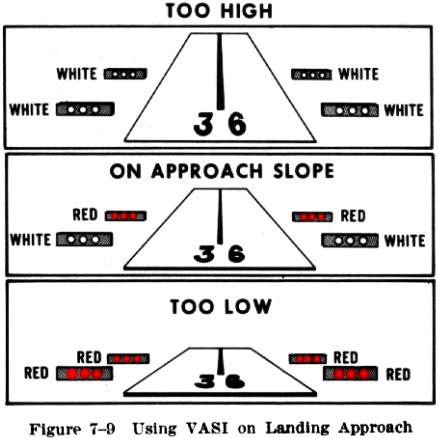Visual Approach Slope Indicator (VASI)
Visual Approach Slope Indicator
(VASI)
| There are many airports equipped with a Visual Approach
Slope Indictor to assist pilots in the landing approach. The VASI provides
a color coded visual glidepath using a system of lights positioned alongside
the runway, near the designated touchdown point. It ensures safety by providing
a visual glidepath which clears all obstructions in the final approach
area. Once the principles and color code of the lighting system are understood,
flying the VASI is a simple matter of noting the light's colors and adjusting
the airplane's rate of descent to stay on the visual glide slope.
The VASI is especially effective during approaches over water or featureless
terrain where other sources of visual reference are lacking or misleading,
and at night. It provides optimum descent guidance for landing and minimizes
the possibility of undershooting or overshooting the designated touchdown
area.
There are several types of VASIs in use including the 2 bar, 3 bar,
and tricolor systems. The basic principle of the 2 bar and 3 bar VASI is
that of color differentiation between red and white. Each light unit projects
a beam of light having a white segment in the upper part of the beam and
red segment in the lower part of the beam (Fig. 7-9). |
|
When on the proper glidepath, the pilot will in effect,
overshoot the downwind bars and undershoot the upwind bars (Fig. 7-8).
Thus, the downwind bars will be seen as white and the upwind bars as red.
From a position below the glidepath the pilot will see all the light bars
as red, and from above the glidepath all the light bars will appear white.
Passing through the glidepath from a low position is indicated to the pilot
by a transition in color from red through pink to white. From a high position,
passing through the path is indicated to the pilot by a transition in color
from white through pink to red.
When the pilot is below the glidepath, the red bars tend
to merge into one distinct red signal. A safe obstruction clearance may
not exist when this distinct red signal is visible. The visual glidepath
will separate into individual lights as the pilot approaches the runway
threshold. At this point, the approach should be continued by reference
to the runway touchdown zone.
Three bar VASI installations provide two visual glidepaths.
The lower glidepath is provided by the near and middle bars and is normally
set at a 3 degree incline while the upper glidepath, provided by the middle
and far bars, is normally 1/4 degree higher. This higher glidepath is intended
for use only by high cockpit aircraft to provide a sufficient threshold
crossing height.
When using a 3 bar VASI it is not necessary to use all
three bars. The near and middle bars constitute a two bar VASI for using
the lower glidepath. Also, the middle and far bars constitute a 2 bar VASI
for using the upper glidepath. The Tricolor Approach Slope Indicator normally
consists of a single light unit, projecting a three color visual approach
path into the final approach area of the runway upon which the system is
installed. In these systems, a below glidepath indication is red, the above
glidepath indication is amber and the on path indication is green.
